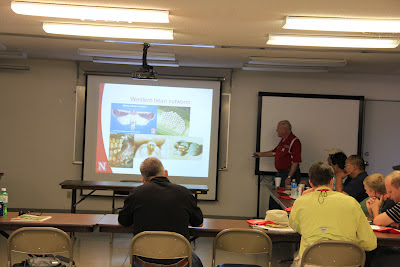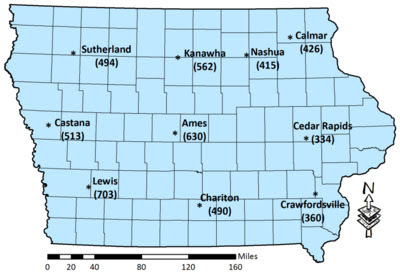Someone recently asked me if aphids make sounds when approached by predators. I thought it was a really interesting question, and not just because it was about my favorite insect! I am not aware of aphids making noise when threatened, although they do have other defense mechanisms I may share at a later time. But it did get me thinking about insects that can make noise and how sound is generated a few different ways.
Cicadas probably come to mind as a well-known noise maker. The males can produce sound, sometimes up to 120 decibels - technically loud enough to cause hearing loss in humans! They have a thin membrane on the outer abdominal wall, called a tymbal. As the abdominal muscles contract and relax, it causes the tymbal to click. Cicadas rapidly vibrate the membrane and the sound amplifies in enlarged air chambers in the abdomen. Each species would have it's own "song" to attract females.
Periodical cicada, www.ipmimages.org.
Most insects stridulate, or rub body parts together, to make noise. In most cases, the males stridulate to attract mates. Crickets and katydids have serrated teeth on the edges of their wings that form comb-like structures. They drag the combs against each other to create sound. But they rub the wings so fast that it just sounds like a chirp. Crickets have four types of chirps: a loud calling song to attract females, a quiet courting song when a female is near, an aggressive song to repel other males, and a brief song after mating. Crickets chirp at different rates depending on the species and temperature. The relationship of cricket chirping is also called
Dolbear's Law.
Field crickets use their wings to create sound. Photo by David Cappaert, Michigan State University, www.ipmimages.org.
Other insects, like grasshoppers and beetles, scrape their legs to make sound. Grasshoppers have stiff peg-like spines on the hind legs that they rub against their wings. Some long-horned grasshoppers will rub their front legs together for their species-specific "songs."
Striped slant-face grasshopper with stiff spines on the hind leg used for stridulation. Photo by Gerry Fauske, North Dakota State University.
Some insects use their heads or even their mouthparts to make clicking noises. But perhaps the weirdest noise-making insect I discovered was the tiny water boatman. This aquatic insect can "sing" at 99 decibels by rubbing its penis against his abdomen. Don't ask me how scientists thought of researching this idea or how they collected the data.
The tiny water boatman can generate a very loud sound, www.bbc.co.uk.
I found a few nice websites that have audio clips of insects making noise. Enjoy!
Insect Sounds,
www.naturesongs.com/insects.html
Bug Bytes,
www.ars.usda.gov/sp2userfiles/person/3559/soundlibrary.html
Songs of Insects,
www.musicofnature.org/songsofinsects/index.html














.jpg)






































